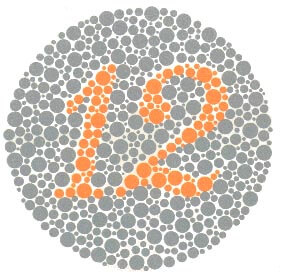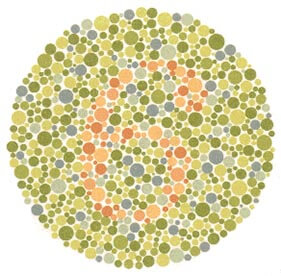Color blindness is a vision condition where individuals struggle to distinguish specific colors or shades. Explore the symptoms and treatment options for this common visual impairment.
İçindekiler
- 1 What is Color Blindness?
- 2 Symptoms of Color Blindness
- 3 What are the Causes of the Disease?
- 4 Perception of the World for Color Blind Individuals
- 5 Diagnosing Color Blindness: Techniques and Methods
- 6 Diverse Forms of Color Blindness
- 7 Treatment Approaches for Color Blindness
- 8 Detecting Color Blindness: A Simple Test (Ishihara Test)
What is Color Blindness?
Color blindness, also known as color vision deficiency, is a visual impairment condition characterized by the inability to perceive certain colors or shades of the same color. The cells responsible for color vision in the retina are known as cone cells, each containing specialized pigments for different colors and shades. Color blindness typically arises from the absence or dysfunction of specific cone cells.
While color blindness is often hereditary and present from birth, it can also develop later in life due to various reasons. The most common form of the condition involves difficulty distinguishing between red and green hues. In rarer cases, individuals may perceive all colors as shades of gray, representing a more severe and uncommon manifestation of the disorder.
It’s important to note that individuals with color blindness can still see colors; however, their perception may differ from those with normal color vision. For example, individuals with red-green color blindness may perceive red and green as tones that are closely related. Interestingly, they can often distinguish between red and green on traffic lights, highlighting the subtle ways in which their perception varies.
Despite its prevalence, many people with color blindness may not be aware of their condition, as they can adapt and compensate for their color vision limitations. Diagnosis typically occurs through tests conducted at health institutions when individuals seek medical attention for various reasons.
Early detection of color blindness holds particular significance, especially for young individuals making career choices. Severe color blindness can pose limitations on employment opportunities in professions where color discrimination is crucial. Therefore, identifying the condition early on allows for informed decision-making and appropriate career planning.
Symptoms of Color Blindness
Contrary to a common misconception, color blindness does not entail a complete inability to see any colors, rendering the world in black and white or a single shade. Instead, color blindness is characterized by difficulty in distinguishing certain colors due to subtle differences in their hues. There are no overt visual symptoms associated with this condition.
The manifestation of color blindness symptoms varies based on whether the individual struggles with perceiving a specific color or experiences complete color blindness. In the case of individuals with color blindness, they typically have the capacity to see colors, but discerning specific hues becomes challenging, particularly when they are faint or closely related. For instance, individuals with red-green color blindness, a prevalent type, perceive red and green, as well as their combinations, as closely resembling tones.
In contrast, total color blindness represents a rare and progressive form of the condition where the individual sees the world in black and white. This extreme form is less common, and most individuals with color blindness experience challenges in differentiating specific colors rather than a complete absence of color perception. It’s important to note that color blindness does not present obvious visual symptoms, making it necessary to undergo specific tests for an accurate diagnosis.
What are the Causes of the Disease?
Color blindness is primarily attributed to hereditary factors, but it can also manifest later in life due to external influences such as drug use and prolonged exposure to chemicals. Disruptions in the cone receptors of the retina, responsible for processing red, green, and blue colors, can lead to challenges in color perception.
Given its hereditary nature, individuals with color blindness are more likely to pass it on to their children. In its congenital form, the transmission often occurs through the X chromosome, making the disease more prevalent in men. Men, having a single X chromosome, are more susceptible, whereas women, with two X chromosomes, may carry the gene without exhibiting symptoms. Consequently, the hereditary transmission dynamics differ between mothers and fathers.
Interestingly, even if parents do not exhibit color blindness, it can still manifest in their children due to hereditary transmission. In cases of later-onset color blindness, contributing factors include optic neuritis, head traumas, macular degeneration, and damage to the optic nerves. Beyond these health conditions, metal poisoning and the use of specific medications can also contribute to the development of color blindness.
Perception of the World for Color Blind Individuals
The way color blind individuals perceive the world is contingent upon the deficiency present in their cone cells. The extent of pigment deficiency dictates their ability to see colors, with some experiencing near-normal vision, albeit with reduced color vibrancy in advanced stages of the condition.
In environments with low or inadequate illumination, color blind individuals may perceive pale colors as more vivid than they truly are. However, in rare instances and as the disease progresses, individuals may eventually perceive the world in black and white. This diminishing spectrum of color perception highlights the dynamic nature of color blindness and the diverse ways it can manifest in different individuals.
Diagnosing Color Blindness: Techniques and Methods
Color blindness is commonly diagnosed through the use of Ishihara plates, a test designed by Professor Shinobu Ishihara from the University of Tokyo. These plates, featuring dotted patterns, display numbers or paths that patients are required to identify during the test.
During the Ishihara test, individuals must discern letters, numbers, and various symbols intertwined in different colors. This assessment aims to gauge the individual’s level of perception and discrimination of the three primary colors.
Another diagnostic method involves the use of colored threads. Individuals suspected of color blindness are asked to distinguish and group these colored threads. Those with color blindness face difficulty in this task as they struggle to discern between certain colors, providing additional insights into their condition. These diagnostic techniques collectively contribute to an accurate assessment of color vision deficiencies.
While various color blindness tests exist, none enjoy the same level of global recognition as the Ishihara test. Designed by Professor Shinobu Ishihara from the University of Tokyo, this test maintains its popularity worldwide for its widespread familiarity and the affordability of the plates used.
The enduring preference for the Ishihara test can be attributed to its effectiveness, ease of use, and accessibility. Its ubiquity makes it a practical choice in diverse healthcare settings, contributing to its continued prominence as the foremost method for diagnosing color blindness on a global scale.
Diverse Forms of Color Blindness
Our eyes house three distinct cone cells responsible for perceiving and distinguishing the colors red, blue, and green, along with their various shades. Color blindness is categorized based on the colors individuals struggle to differentiate, leading to three primary classifications.
- Green Color Vision Disorder (Deuteranopia): Green color vision deficiencies constitute the most prevalent forms of color blindness. This subtype, observed in around 6% of men in the population, is commonly identified as a mild form of deuteranomaly, a type of red-green color blindness.
- Red Vision Disorder (Protanopia): Protanopia arises from the absence or dysfunction of red color-sensitive cone cells. This deficiency impacts the perception of red hues and is a distinct category within the spectrum of color blindness.
- Blue Vision Disorder (Tritanopia): Tritanopia occurs due to the absence or dysfunction of blue color-sensitive cone cells. This type of color blindness is rarer compared to deuteranomaly and protanopia, affecting the ability to perceive and distinguish blue hues.
Understanding these classifications provides valuable insights into the specific color deficiencies individuals may experience, contributing to more targeted diagnosis and management of color vision impairments.
Treatment Approaches for Color Blindness
As color blindness often stems from genetic factors in many cases, traditional medical interventions such as medications or surgeries are generally ineffective. The primary goal of treatment is to enhance the overall quality of life for individuals with color vision deficiencies.
Specialized glasses and contact lenses, designed with specific density for the three fundamental colors (red, green, and blue), represent a promising approach to improve color perception in affected individuals. Wearing these corrective lenses can significantly enhance the patient’s ability to see and distinguish colors, contributing to an improved visual experience.
Early detection through comprehensive eye examinations is of paramount importance, particularly for individuals, especially children, with a family history of color blindness. Identifying the condition at an early stage enables timely interventions and the implementation of strategies to support individuals in adapting to and overcoming the challenges associated with color vision deficiencies.
Detecting Color Blindness: A Simple Test (Ishihara Test)
A straightforward method for identifying color blindness involves a test where individuals must accurately perceive numbers on color plates. Failure to correctly identify the numbers may indicate color blindness. It’s worth noting that while this test is a useful initial screening tool, the most precise and comprehensive diagnosis is achieved through a detailed eye examination conducted by a qualified eye care professional.
Below, we present a color blindness test featuring 17 Ishihara Test Plates. Each plate assesses color vision from a distinct perspective, providing a comprehensive evaluation. This test serves as a valuable tool to raise awareness about potential color vision deficiencies, but professional medical assessment remains crucial for an accurate diagnosis and personalized guidance.




















The Benefits of Wearing Sunglasses and How to Choose Them
Wearing sunglasses plays a vital role in protecting our eye health. However, choosing the wrong [...]
Devamını OkuyunSep
The Effects of Eyelash Trimming on Eye Health
Trimming eyelashes has recently gained popularity on social media, especially among men. While it may [...]
Devamını OkuyunSep
The Benefits of the Mediterranean Diet for Macular Degeneration
Diet plays a significant role in slowing the progression of macular degeneration, and the Mediterranean [...]
Devamını OkuyunApr
What is Dry Eye? Tips to Protect Yourself from Dry Eyes
Insufficient tear production can lead to discomfort and reduce your eyes’ ability to defend against [...]
Devamını OkuyunJan
Understanding the Structure of the Eye and Its Functions?
Understanding the anatomy of the eye is crucial for diagnosing and treating various eye conditions. [...]
Devamını OkuyunJan
Causes and Treatment of Eye Floaters
Occasionally, individuals may notice floating objects in their field of vision. These can take various [...]
Devamını OkuyunMay
What is Vitreous? How is Vitreous Dysfunction Treated?
Vitreous, derived from the Latin term meaning “glassy,” is a clear gel found between the [...]
Devamını OkuyunMay
Vision Wellness Essentials: Simple and Effective Tips for Eye Health
Our eyes, vital and health-sensitive organs, demand special care to combat conditions such as eye [...]
Devamını OkuyunJan